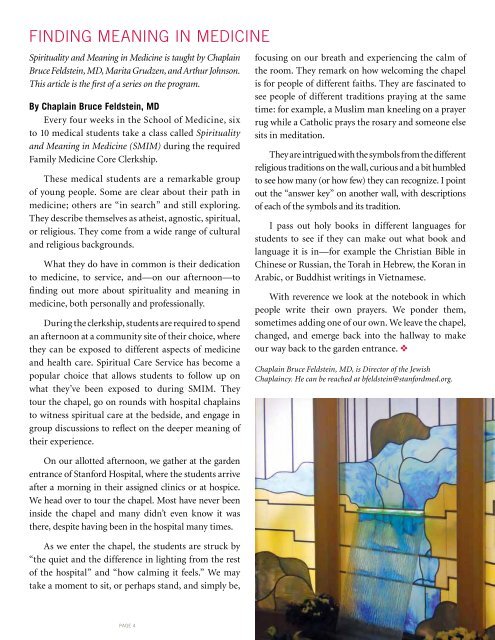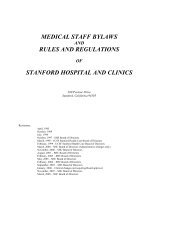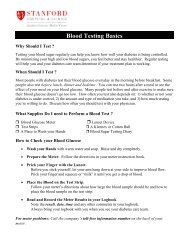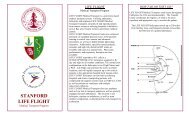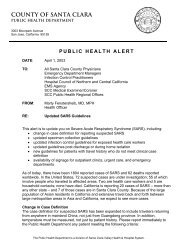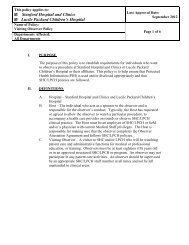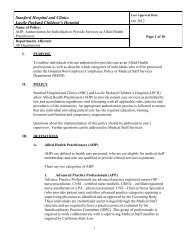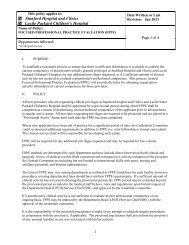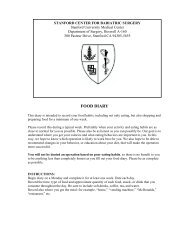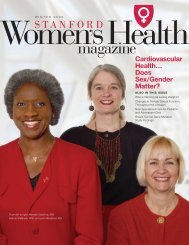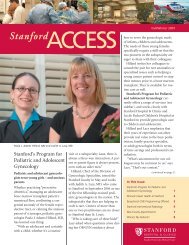SPIRITUAL CARE NOTES - Stanford Hospital & Clinics
SPIRITUAL CARE NOTES - Stanford Hospital & Clinics
SPIRITUAL CARE NOTES - Stanford Hospital & Clinics
You also want an ePaper? Increase the reach of your titles
YUMPU automatically turns print PDFs into web optimized ePapers that Google loves.
FINDINg mEANINg IN mEDICINE<br />
Spirituality and Meaning in Medicine is taught by Chaplain<br />
Bruce Feldstein, MD, Marita Grudzen, and Arthur Johnson.<br />
This article is the first of a series on the program.<br />
By Chaplain Bruce Feldstein, MD<br />
Every four weeks in the School of Medicine, six<br />
to 10 medical students take a class called Spirituality<br />
and Meaning in Medicine (SMIM) during the required<br />
Family Medicine Core Clerkship.<br />
These medical students are a remarkable group<br />
of young people. Some are clear about their path in<br />
medicine; others are “in search” and still exploring.<br />
They describe themselves as atheist, agnostic, spiritual,<br />
or religious. They come from a wide range of cultural<br />
and religious backgrounds.<br />
What they do have in common is their dedication<br />
to medicine, to service, and—on our afternoon—to<br />
finding out more about spirituality and meaning in<br />
medicine, both personally and professionally.<br />
During the clerkship, students are required to spend<br />
an afternoon at a community site of their choice, where<br />
they can be exposed to different aspects of medicine<br />
and health care. Spiritual Care Service has become a<br />
popular choice that allows students to follow up on<br />
what they’ve been exposed to during SMIM. They<br />
tour the chapel, go on rounds with hospital chaplains<br />
to witness spiritual care at the bedside, and engage in<br />
group discussions to reflect on the deeper meaning of<br />
their experience.<br />
On our allotted afternoon, we gather at the garden<br />
entrance of <strong>Stanford</strong> <strong>Hospital</strong>, where the students arrive<br />
after a morning in their assigned clinics or at hospice.<br />
We head over to tour the chapel. Most have never been<br />
inside the chapel and many didn’t even know it was<br />
there, despite having been in the hospital many times.<br />
As we enter the chapel, the students are struck by<br />
“the quiet and the difference in lighting from the rest<br />
of the hospital” and “how calming it feels.” We may<br />
take a moment to sit, or perhaps stand, and simply be,<br />
PAGE 4<br />
focusing on our breath and experiencing the calm of<br />
the room. They remark on how welcoming the chapel<br />
is for people of different faiths. They are fascinated to<br />
see people of different traditions praying at the same<br />
time: for example, a Muslim man kneeling on a prayer<br />
rug while a Catholic prays the rosary and someone else<br />
sits in meditation.<br />
They are intrigued with the symbols from the different<br />
religious traditions on the wall, curious and a bit humbled<br />
to see how many (or how few) they can recognize. I point<br />
out the “answer key” on another wall, with descriptions<br />
of each of the symbols and its tradition.<br />
I pass out holy books in different languages for<br />
students to see if they can make out what book and<br />
language it is in—for example the Christian Bible in<br />
Chinese or Russian, the Torah in Hebrew, the Koran in<br />
Arabic, or Buddhist writings in Vietnamese.<br />
With reverence we look at the notebook in which<br />
people write their own prayers. We ponder them,<br />
sometimes adding one of our own. We leave the chapel,<br />
changed, and emerge back into the hallway to make<br />
our way back to the garden entrance. v<br />
Chaplain Bruce Feldstein, MD, is Director of the Jewish<br />
Chaplaincy. He can be reached at bfeldstein@stanfordmed.org.


